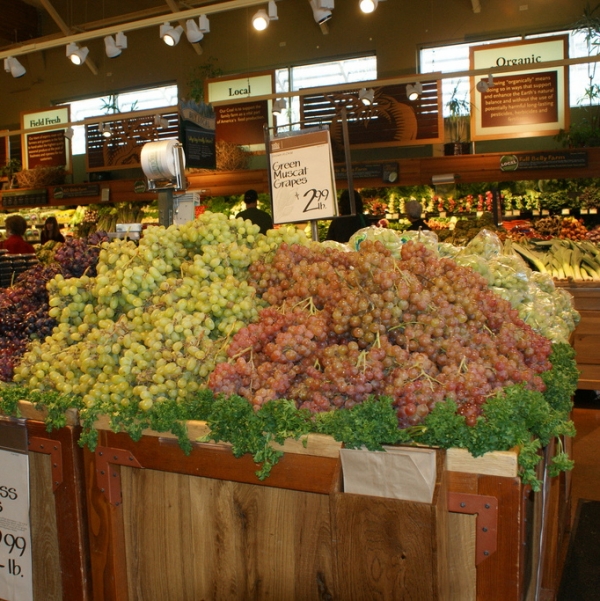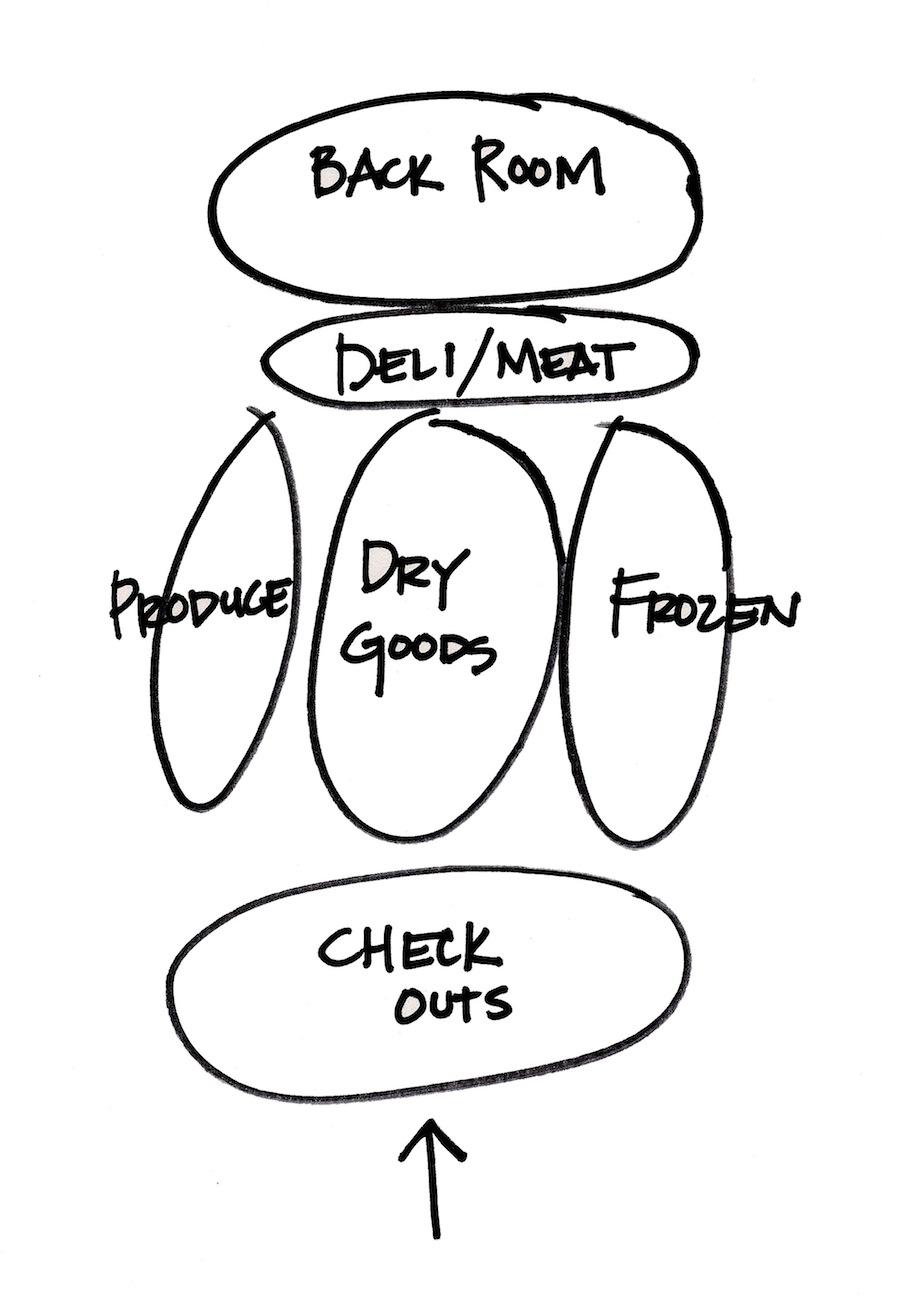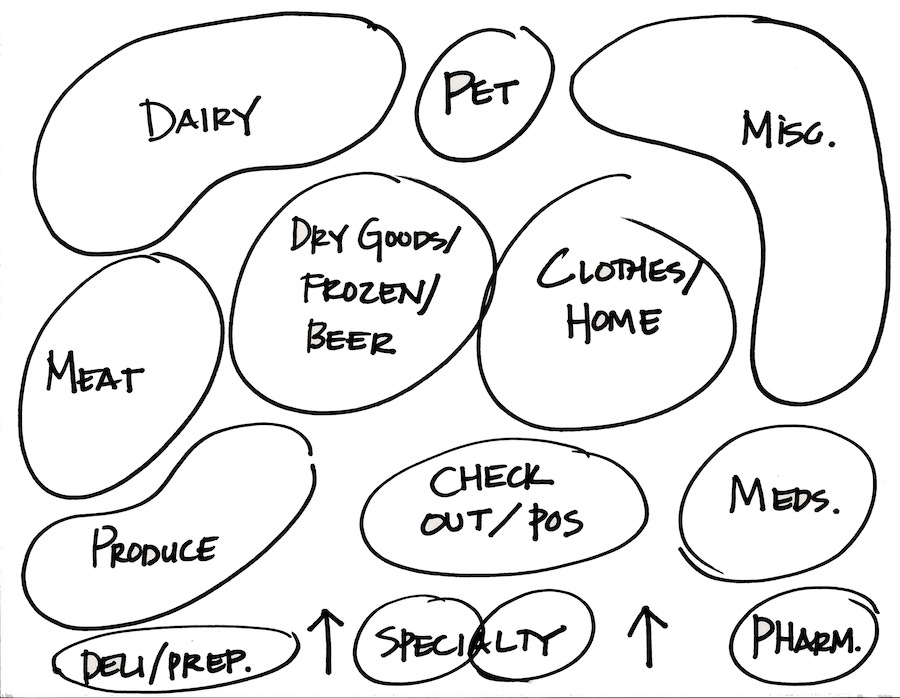Today's Grocery Store
Grocery stores have undergone significant changes over the past decade. Fifteen years ago, if a recipe called for a rare ethnic ingredient, you would have to search all across town for it; now the average mega mart has most of the ethnic ingredients you could ever want. For years, grocery stores veered away from the old time service meat and deli counters and focused on self serve. The size of the grocery store has expanded at a rapid rate; the average mega mart is around 50,000 square feet. The stores started to feel less inviting and more sterile, much like a warehouse. Grocery chains seemed to have lost touch with the customer. Now jump to the present: the grocery store of 2009 is no less than a one-stop shop with all the bells and whistles. Our grocery stores of today supply us with fresh food, dry goods, prepared foods, toiletries, housewares, clothes and even banks. They have come a long way, and so have the designs.
 http://www.flickr.com/photos/74822033@N00/ / CC BY-ND 2.0
http://www.flickr.com/photos/74822033@N00/ / CC BY-ND 2.0
 If we look at how a grocery store would have been laid out in the past, you will see the typical one entry way, with two doors: in and out. Once in the door, the cash registers would greet you, then you would make your way around to the dry goods, then maybe over an aisle to the frozen foods. Stop by the meat counter on your way to the small produce area, then off to the registers. With the old layouts, produce took second stage. It either was housed in a side aisle or in the back corner of store. The meat/deli area was located in the rear of the store with a butcher. The back room was used for storage and any prep work was located within the meat/deli area. Dry goods were always right there in the center, but lacked any featured products. The design was very basic: narrow aisles, low lighting, basic wall and floor colors, and limited product. Now we turn to today’s grocery store concept: it typically has two large entrances with glass all around; the check outs/POS (points of sale) are still up front, but the entrances lead you into other areas. Picture it, you are now entering through the vast array of fresh produce and vegetables, with featured products all around. Intermingled between the fruits and veggies is a huge assortment of organic options. Over to your right you notice a large rotisserie with freshly cooked chickens; the smell carries all through the area. Next to the chicken are containers full of pastas, salads, and even pizzas, all ready for you take home and heat up. As you move on, you find the meat and deli area, which takes you back to the old days of the butcher standing behind the counter waiting to serve. Then you venture on and now notice the vast number of dry goods aisles, everything you could think of. Many aisles have areas that are showcasing a new product. After you stroll through the dry goods, you come across the rows of frozen food. Then off for some milk before heading to the check out, and the cases line the corner of store with all of the dairy and cold products. Just as you were about to leave, you spot your favorite coffee shop right there in the store …how great it that! All the while you did not even realize that you just walked through the entire store. The intention to have you walk through the entire store was there all the way from the beginning.
If we look at how a grocery store would have been laid out in the past, you will see the typical one entry way, with two doors: in and out. Once in the door, the cash registers would greet you, then you would make your way around to the dry goods, then maybe over an aisle to the frozen foods. Stop by the meat counter on your way to the small produce area, then off to the registers. With the old layouts, produce took second stage. It either was housed in a side aisle or in the back corner of store. The meat/deli area was located in the rear of the store with a butcher. The back room was used for storage and any prep work was located within the meat/deli area. Dry goods were always right there in the center, but lacked any featured products. The design was very basic: narrow aisles, low lighting, basic wall and floor colors, and limited product. Now we turn to today’s grocery store concept: it typically has two large entrances with glass all around; the check outs/POS (points of sale) are still up front, but the entrances lead you into other areas. Picture it, you are now entering through the vast array of fresh produce and vegetables, with featured products all around. Intermingled between the fruits and veggies is a huge assortment of organic options. Over to your right you notice a large rotisserie with freshly cooked chickens; the smell carries all through the area. Next to the chicken are containers full of pastas, salads, and even pizzas, all ready for you take home and heat up. As you move on, you find the meat and deli area, which takes you back to the old days of the butcher standing behind the counter waiting to serve. Then you venture on and now notice the vast number of dry goods aisles, everything you could think of. Many aisles have areas that are showcasing a new product. After you stroll through the dry goods, you come across the rows of frozen food. Then off for some milk before heading to the check out, and the cases line the corner of store with all of the dairy and cold products. Just as you were about to leave, you spot your favorite coffee shop right there in the store …how great it that! All the while you did not even realize that you just walked through the entire store. The intention to have you walk through the entire store was there all the way from the beginning.
 The store design starts out at the entrance, where you begin in a large fresh produce area. Today’s produce areas are the showcase of the stores. Consumers love things that are fresh and vibrant, so what better way to start the shopping experience than produce? Prepared foods have also made their way into the grocery stores, as shoppers want fast, easy and tasty; prepared foods include rotisserie chickens and ready to bake pizzas. The meat and deli areas are the old time butchers of the future. They have the old time attendant behind the counter, but also have various self serve cases that contain every meat/ deli item you could want. The meat and deli areas have managed to retain the great aspects of the old ones, but integrate the desired new technology and designs of today. The center store, which contains dry goods, toiletries and other items, is placed in the center with a purpose. With dry goods and such in the middle, the shopper has to walk through other areas in order to get to the basics. It is a brilliant concept; the more items you expose the customer to, the more they will buy. Frozen foods are still contained in large upright units, but today’s are sleek and exceptionally well lit. They make it easy for the store workers to highlight the frozen products. The dairy area is also designed to lead you around, which is why in many layouts it is in an L shape. Dairy is a heavily traveled area, so it is necessary to design it so traffic will flow on to other areas. Unlike the older grocery stores, beer and wine are now highlighted in stores. The alcohol industry is very profitable, and the designers are keen to this when designing. Today’s grocery stores highlight wine and beer in unique ways; some even have entire “beer caves” devoted to them. Even the check outs are crafted with the customer in mind. Today’s shopper wants 'quick and quicker', so the check outs or POS are designed to be efficient and easy to use. With the trend of self-check outs, stores are able to offer an even faster option for the customer. Finally, the specialties, such as your favorite coffee shop, fast food chain, and bank. As discussed before, the shopper of today wants it all in one, so designs now include it. The specialty shops are located up front, so on the way out you can grab a cup of joe and a sandwich, or even cash a check. Today's supermarkets truly are a one-stop shop, even without including the clothes and housewares departments that many have.
The store design starts out at the entrance, where you begin in a large fresh produce area. Today’s produce areas are the showcase of the stores. Consumers love things that are fresh and vibrant, so what better way to start the shopping experience than produce? Prepared foods have also made their way into the grocery stores, as shoppers want fast, easy and tasty; prepared foods include rotisserie chickens and ready to bake pizzas. The meat and deli areas are the old time butchers of the future. They have the old time attendant behind the counter, but also have various self serve cases that contain every meat/ deli item you could want. The meat and deli areas have managed to retain the great aspects of the old ones, but integrate the desired new technology and designs of today. The center store, which contains dry goods, toiletries and other items, is placed in the center with a purpose. With dry goods and such in the middle, the shopper has to walk through other areas in order to get to the basics. It is a brilliant concept; the more items you expose the customer to, the more they will buy. Frozen foods are still contained in large upright units, but today’s are sleek and exceptionally well lit. They make it easy for the store workers to highlight the frozen products. The dairy area is also designed to lead you around, which is why in many layouts it is in an L shape. Dairy is a heavily traveled area, so it is necessary to design it so traffic will flow on to other areas. Unlike the older grocery stores, beer and wine are now highlighted in stores. The alcohol industry is very profitable, and the designers are keen to this when designing. Today’s grocery stores highlight wine and beer in unique ways; some even have entire “beer caves” devoted to them. Even the check outs are crafted with the customer in mind. Today’s shopper wants 'quick and quicker', so the check outs or POS are designed to be efficient and easy to use. With the trend of self-check outs, stores are able to offer an even faster option for the customer. Finally, the specialties, such as your favorite coffee shop, fast food chain, and bank. As discussed before, the shopper of today wants it all in one, so designs now include it. The specialty shops are located up front, so on the way out you can grab a cup of joe and a sandwich, or even cash a check. Today's supermarkets truly are a one-stop shop, even without including the clothes and housewares departments that many have.
The design of a grocery is rarely, if ever, thought about by the customer, and that is the idea. The layout is designed to lead the shopper throughout the store, whether they intended to walk through or not. You may have come with the intention of buying bread, milk and eggs, but via the clever design and layout of the fixtures, cases, and aisles, you ended up buying twelve other items. Today’s grocery stores have different factors to consider than their predecessors: rapid technology growth, need for speed, environmental concerns, demographics, and a need for a one-stop shop. It does not just involve the basics anymore; customers expect it all, including the amenities like banks, fast food restaurants, and even nail salons. So next time you walk into your favorite grocery store, take a minute to check out the design - it’s worth a look.

Cindy Eastep
Cindy is a graduate of Bowling Green State University, with a Bachelor of Arts in Interior Design. Cindy has experience with a wide variety of commercial architectural and design projects including restaurants, grocery stores, retail establishments, and big box. She has a strong background in food service design and is a Certified Food Service Professional (CFSP). She has been involved in all stages of design, from the conceptualization to the final construction of a building. Cindy’s experiences as a food service designer, prototype designer, and project manager bring a strong technical and design background to Buildipedia.com.

